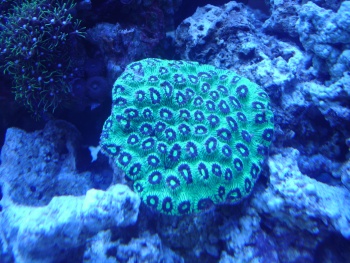
By Bob Goemans


Likely Reef Tank Suitable
Likely Fish-Only Tank Suitable
This large family, containing 25 genera, is the second largest family of stony (scleractinians) corals behind that of Acroporids. Those in these genera are among the most widely and uniformly distributed corals in the world as they are commonly found throughout the Indo-West Pacific, with a Favia species, F. fragum also found in the Eastern Atlantic, Brazilian region and the Caribbean. Colors vary greatly with origin, and different combinations of yellow, red, green, brown, cream, and purple are often available in the trade.
Most are massive, domed or round in shape. Yet geographical differences, e.g., depth, current, and local nutrient levels make individual species identification almost impossible by hobbyists, as the exact same species from a different location can have different colors and shape. To somewhat help with species identification, the Favia genus was divided into three groups according to their corallite size (the skeletal area containing the polyp). In fact, that's similar to what occurred when the Acanthastrea genus was incurring numerous new species and was divided with smaller corallite species placed into a 'new' Micromussa genus.
There are three corallite size divisions in the genus Favia, with those in 'Group 1' having corallites less than 8 mm in diameter. Group 2 has those averaging 8 - 12 mm, and those in Group 3 more than 12 mm. Those in the Favites genus were also divided into groups, e.g., those with less than 6 mm placed into Group 1. Those averaging 6 - 10 mm placed into Group 2; those with 10 - 14 mm corallites into Group 3, and those over 14 mm into Group 4. Even with all these subdivisions, its still necessary in most cases to await the retraction of the fleshy mantle/polyp so corallite size is more apparent before any species identification is attempted. Except for the 'experts,' most exact species identification, at least in my opinion, is still mostly guesswork.
Where hobbyists are concerned, there has been some confusion between the two genera as to which genus a specimen may belong. But if one looks closely, those in the Favia genus have separate corallites whereas those in the Favites genus share their corallite walls with other corallites. Another distinguishing aspect is Favia polyps are sometimes seen as figure-8 shapes, as they are dividing, whereas those on Favites are forming totally separate corallites usually in the area around the circumference of the coral. Favites also have higher corallites than those associated with Favia species and tend to be more uneven in height.
Exact species identification is always helpful, as the selected specimen's placement in the aquarium should be similar to its natural habitat if at all possible. Yet few are ever properly/exactly identified in the trade and are usually sold labeled as: Moon Coral, Brain Coral, Pineapple Coral, Crater Coral, Star Coral, Closed Brain Coral, and Honeycomb Coral to mention just some of their common names. Others are simply labeled a 'Favia sp./species' or 'Favites sp.' Unfortunately that tells one little as to their status in the wild. But if one applies the corallite structure as mentioned above, the specimen can possibly be placed into at least one or the other genera and perhaps narrowed to an exact species. From there it can be found what the specimen endures in the wild, e.g., what depth its usually found at, its location of the reef, water movement/current aspects, and other surrounding conditions. Books, e.g., Corals of the World will help narrow their exact identification and provide some of those aspects.
If exact identification is not possible, take into consideration many are found on protected upper reef slopes at depths between 20 - 35 feet (6 - 10 m). This tends to indicate that gentle to moderate water movement and moderate to bright light are required to maintain them in aquaria. Keep in mind overly strong water movement will prevent polyps from extending, and/or cause tissue recession possibly allowing a microalgae such as 'Ostreobium' to infest its barren skeleton, hastening tissue recession. In well-lit aquariums, consider locating new specimens somewhat low in the aquarium to first allow them to become accustomed to their new surroundings, and then if desired after a week or two moved to more brightly lit areas. Growth seems to stagnate in those maintained at lower light levels.
Though all species in both genera are quite hardy, they are aggressive, distributing stinging sweeper tentacles at nighttime. Spacing between neighboring corals, especially those downstream, must be given some thought before placing them in the aquarium. On the other side of the coin so to speak, there are some animals that may cause them damage, such as various fish species in the genus Centropyge, which are normally a watch item, as some, especially Flame Angels have a record of picking on clams and some corals. Then there are shrimp, such as those in the genus Saron and Rhynchocinetes, which cannot be fully trusted with many corals.
Even though these are photosynthetic corals and under the proper lighting conditions are able to supply their own nutritional needs, additional spot feeding can encourage growth and coloration. On the other hand, if under inadequate lighting, then direct feeding once or twice a week 'is' necessary with meaty foodstuffs made from a variety of different foodstuffs, e.g., scallops, krill, rotifers, copepods, baby brine shrimp, and mysis shrimp.